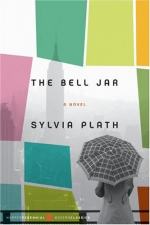|
This section contains 5,089 words (approx. 17 pages at 300 words per page) |

|
SOURCE: "Plath's The Bell Jar as Female Bildungsroman," in Women's Studies, Vol. 12, No. 1, 1986, pp. 55-68.
In the following essay, Wagner examines The Bell Jar as the chronicle of a young woman's psychological development and search for identity. As Wagner notes, Plath's depiction of the heroine's madness and thinly veiled anger at patriarchal society differs from the traditional bildungsroman in which the author strives to provide moral education.
One of the most misunderstood of contemporary novels, Sylvia Plath's The Bell Jar is in structure and intent a highly conventional bildungsroman. Concerned almost entirely with the education and maturation of Esther Greenwood, Plath's novel uses a chronological and necessarily episodic structure to keep Esther at the center of all action. Other characters are fragmentary, subordinate to Esther and her developing consciousness, and are shown only through their effects on her as central character. No incident is included which does not...
|
This section contains 5,089 words (approx. 17 pages at 300 words per page) |

|


